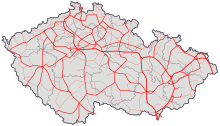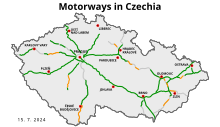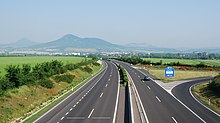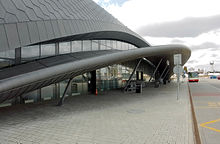Transport in the Czech Republic

Transport in the Czech Republic relies on several main modes, including transport by road, rail, water and air.
Railways

The Czech Republic has a total railway length of 9,435 kilometres (5,863 mi) which makes it a country with the second highest rail density in the world.[1] The vast majority (9,341 kilometres (5,804 mi)) is standard gauge. Electrified railways generally have voltages of 3 kV DC or 25 kV AC. 94 kilometres (58 mi) of track is narrow gauge. The most prominent Czech railway company is the state-owned České dráhy (ČD) (English: Czech Railways). Prague has an underground rapid transit system, the Prague Metro. In addition, the cities of Brno, Liberec, Most, Olomouc, Ostrava, Plzeň, and Prague have tram systems.
Roads


The Czech Republic has, in total, 55,653 km (34,581 mi)[2] of roads. It has 1,247 km (775 mi)[3] of motorways. In the 1980s and 1990s there was a significant increase in passenger transport on the roads in the Czech Republic, which was associated with a sharp increase in the accident rate. Between 2007 and 2013, the death rate fell in every year, with a record low of 583 deaths in 2013, compared with the 1994 high of 1,473 casualties.[4] Despite this however, the fatality rate per head of population is moderately high, comparable to the United States.[2]
Highways
There are 2 main categories of roads forming the main network: Motorways and Highways. These roads are managed by the state-owned Directorate of Highways and Motorways of the Czech Republic – ŘSD, established in 1997. Among the first modern motorways in the Czech Republic was the motorway from Prague to the Slovak border through Brno whose construction was started on May 2, 1939.
Motorways are dual carriageways with tolls and a speed limit of 130 km/h. Highways can be single and dual carriageway with a speed limit of 90 km/h (dual carriageways are commonly signposted as Roads for motorcars with a speed limit of 110 km/h).
ŘSD currently manages and maintains 1,369 km of motorways (dálnice).[3]
Waterways
The Vltava is the country's longest river, at 430 km. 358 km of the Elbe (Labe), which totals 1154 km, is also present in the country. An artificial waterway, nowadays used for recreation, is the Baťa Canal.
Ports and harbors
Děčín, Mělník, Prague, Ústí nad Labem, Moldauhafen in Hamburg (no longer operational, will be handed over to Germany in 2028)
Airports


In 2006, the Czech Republic had a total 121 airports. 46 of these airports had paved runways while 75 had unpaved runways. The largest and busiest airport in the Czech Republic is Václav Havel Airport Prague, opened in 1937. Other international airports include Brno–Tuřany Airport, Karlovy Vary Airport, Ostrava Leoš Janáček Airport, Pardubice Airport, Kunovice Airport and Public domestic and private international airport is for example Hradec Králové Airport.
- Airports with paved runways
Total: 46 (2007)
- Over 3,047 m: 2
- 2,438 to 3,047 m: 10
- 1,524 to 2,437 m: 13
- 914 to 1,523 m: 2
- Under 914 m: 19
- Airports with unpaved runways
Total: 75 (2007)
- 1,524 to 2,437 m: 1
- 914 to 1,523 m: 25
- Under 914 m: 49
Heliports
2 (2006)
See also
- Czech Republic
- List of airports in the Czech Republic
- Road signs in the Czech Republic
- European driving licence
References
- ^ "Europe: rail network density by country size 2019". Statista. Retrieved 2023-12-01.
- ^ a b "Transport in Czech Republic". International Transport Statistics Database. IRAP. 2008-04-13. Retrieved 2008-10-06.
- ^ a b "České dálnice".
- ^ "Number of traffic victims in Czech Republic lowest in history in 2013". ceskenoviny.cz. 1 January 2014. Retrieved 30 January 2014.
External links
- Czech Transport
- idos.cz - public transport on-line timetables and trip planner (sponsored by the government)
- Transport in the Czech Republic

